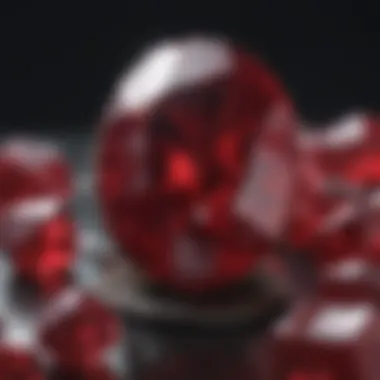Unveiling the Most Coveted Gemstones of the World: A Journey into Precious Treasures


Gemstones hold a timeless allure, fascinating collectors and enthusiasts alike with their beauty and rarity. From the coveted diamonds to the vibrant emeralds, each gemstone carries a unique charm and historical significance that has captivated individuals for centuries. This comprehensive guide explores the origins, characteristics, and cultural relevance of the most valued gemstones worldwide, offering a peek into the enchanting world of precious stones.
Rock and Fossil Identification
Gemstone identification is a meticulous process that requires a keen eye and an understanding of various types of gemstones. Characteristics such as color, clarity, cut, and carat weight play a crucial role in distinguishing one gemstone from another. To aid in this identification process, gemologists utilize specialized tools like loupes, microscopes, and refractometers to examine and analyze the unique traits of each gemstone.
Collecting Tips and Techniques
For rock and fossil collectors, honing collecting skills is essential to finding and acquiring prized specimens. Best practices include researching prime collecting sites known for yielding high-quality gemstones, as well as networking with other collectors to exchange knowledge and tips. Safely extracting specimens from their natural settings requires delicate handling to avoid damaging the stones and preserving their intrinsic value.
Preservation and Display
Preserving gemstones is crucial to maintaining their beauty and integrity over time. Techniques such as storing gemstones in a cool, dark environment to prevent color fading and utilizing soft cloth pouches to prevent scratches ensure longevity. Creative display ideas showcase gemstones in their full splendor, whether through elegant jewelry settings, museum-worthy displays, or intricately designed cases that highlight each gemstone's individual brilliance.
Geological Insights
Delving into the geological underpinnings of gemstone formation provides a deeper appreciation for these natural marvels. Understanding the geological processes that shape gemstones, such as heat, pressure, and mineral composition, unveils the intricate beauty of these treasures. Exploring the historical significance of gemstones and notable discoveries in the field adds a layer of intrigue to the already enchanting world of gemstones.
Introduction
At the heart of this exploration is the recognition of gemstones not just as ornamental accessories but as embodiments of symbolism, artistry, and even geological phenomena. Each gemstone carries within it a story of formation, rarity, and beauty that transcends mere aesthetic value. By understanding the origins, characteristics, and cultural significance of these gems, we can appreciate the depth of their allure and the diverse narratives they encapsulate.
Delving into the nuances of gemstones opens a door to a realm where science meets art, where rarity meets craftsmanship, and where history meets modern fascination. Throughout this article, we aim to unveil the breadth of knowledge surrounding these precious stones, offering insights that resonate with rock and fossil collectors, as well as enthusiasts seeking a deeper understanding of the world of gemstones. Join us in this exploration as we uncover the hidden treasures and enduring legacies of the most valued gemstones on the planet.
Diamonds
Formation of Diamonds
The formation of diamonds is a fascinating natural process that unfolds over millions of years deep within the Earth's mantle. Carbon, subjected to immense pressure and temperature, crystallizes to create the stunning gemstone we recognize as a diamond. The intricate journey from carbon atoms to a lustrous diamond involves intense geological forces and specific conditions that contribute to their exceptional hardness and brilliance.


Famous Diamonds in History
Throughout history, certain diamonds have achieved legendary status due to their remarkable size, rarity, and historical provenance. From the infamous Hope Diamond shrouded in mystery and folklore to the awe-inspiring Koh-i-Noor with a storied past intertwined with multiple civilizations, these famous diamonds evoke intrigue and fascination. Their tales of ownership, intrigue, and symbolism offer insights into the enduring appeal and mystique of diamonds as coveted treasures.
Diamond Characteristics
Diamonds boast a myriad of defining characteristics that distinguish them as one of the most coveted gemstones in the world. Their exceptional hardness, measured on the Mohs scale as a perfect 10, ensures durability and longevity, making them ideal for heirloom jewelry pieces that withstand the test of time. Furthermore, diamonds exhibit unparalleled brilliance and fire, thanks to their superior light-reflecting properties, captivating beholders with their scintillating allure and dazzling play of light.
2. Rubies
Rubies hold a paramount position in the realm of gemstones, revered for their unparalleled beauty and historical significance. In this article, the focus on rubies aims to shed light on the exquisite nature of these gemstones and their distinct allure compared to other coveted stones. By delving into the origins, symbolism, and notable mines of rubies, we aim to provide a comprehensive understanding of why they are one of the most valued gemstones globally.
Origins of Rubies
Originating primarily from regions such as Myanmar, Thailand, and Sri Lanka, rubies have a rich history dating back centuries. The geological formations where rubies are found play a crucial role in determining their quality and color intensity. Understanding the geological processes that give rise to these precious gems adds a layer of appreciation for their rarity and uniqueness.
Symbolism of Rubies
Rubies have long been associated with attributes such as passion, prosperity, and protection. Across various cultures and belief systems, rubies hold symbolic significance, often representing love, courage, and vitality. Exploring the symbolism attached to rubies unveils the deep-rooted cultural values and mythologies that have elevated these gemstones to a status of reverence and admiration.
Notable Ruby Mines
From the famed Mogok mines in Myanmar to the vibrant mines of Mozambique, the world is replete with locations that yield exquisite rubies. The distinct characteristics of rubies sourced from different mines, such as size, color saturation, and clarity, showcase the diversity within this gemstone category. By highlighting the notable ruby mines worldwide, we aim to underscore the geographical significance and geological marvels that contribute to the magnificence of rubies.
3. Sapphires
Sapphires hold a prominent place in the realm of gemstones, renowned for their exquisite beauty and enduring appeal. In this article, the section dedicated to sapphires sheds light on their significance and allure in the world of precious stones. Sapphires, with their striking hues and mesmerizing luster, captivate collectors and enthusiasts alike, making them a cornerstone in any discussion about esteemed gemstones.
Ceylon Sapphires


Ceylon sapphires, originating from Sri Lanka, stand out for their exceptional quality and stunning color variations. These sapphires are revered for their clarity and brilliance, drawing admiration from connoisseurs worldwide. The allure of Ceylon sapphires lies not only in their physical attributes but also in their rich history and cultural significance.
Star Sapphires
Star sapphires exude a mystical charm, characterized by a unique phenomenon called asterism that forms a star-like pattern within the stone. The optical effect of a star shimmering across the surface of the sapphire contributes to its enchanting allure. Esteemed for their rarity and captivating appearance, star sapphires hold a special place among the world's most desired gemstones.
Famous Sapphire Jewelry Pieces
Famous sapphire jewelry pieces have graced royal collections and adorned iconic figures throughout history, reflecting the enduring appeal of these majestic gemstones. From regal tiaras to exquisite rings, sapphires have been prominently featured in high-end jewelry designs, symbolizing elegance and sophistication. Notable examples include the stunning engagement ring worn by Princess Diana, showcasing the timeless beauty and significance of sapphires in the world of gemstone jewelry.
4. Emeralds
Colombian Emeralds
Colombian emeralds are revered worldwide for their exceptional quality and stunning color. Originating from the mines of Colombia, these emeralds are renowned for their vivid green hue, known as 'emerald green,' which sets them apart from emeralds sourced elsewhere. The geographic conditions of the Colombian mines contribute to the formation of emeralds with exceptional clarity and brilliance, making them highly sought after in the gemstone market. The rich history and cultural significance of Colombian emeralds add to their allure, with legends attributing mystical properties and healing powers to these precious stones.
Emerald Mythology
Emeralds have held a special place in various mythologies and cultures throughout history. Often associated with themes of rebirth, love, and prosperity, emeralds have been revered for their perceived mystical properties. In ancient times, emeralds were believed to bring good fortune and foresight to those who wore them, with some cultures considering them a symbol of immortality. The rich symbolism and mythology surrounding emeralds contribute to their timeless appeal and make them a treasured gemstone for generations.
Notable Emerald Mines
Emeralds are mined in various locations worldwide, with notable mines contributing to the supply of these precious gems. From the historic Muzo mines in Colombia to the Panjshir Valley mines in Afghanistan, each mining region offers emeralds with distinct characteristics and qualities. The significance of these mines goes beyond their economic value, as they play a crucial role in preserving the tradition and artistry of emerald mining. By exploring the renowned emerald mines around the globe, we gain insight into the diverse origins and unique features that define these captivating gemstones.
5. Opals
Fire Opals
Fire opals, distinguished by their vivid orange to red hues, hold a special place in the world of opals. This subsection delves into the fiery allure of these opals, exploring their formation process, geographical sources, and the factors that contribute to their exquisite color range. Readers will gain a deeper understanding of the distinct properties and qualities that make fire opals a coveted choice among gemstone connoisseurs.


Black Opals
Black opals, renowned for their dark body tone with vibrant play-of-color, symbolize sophistication and elegance in the realm of gemstones. In this section, the focus shifts to the allure of black opals, examining their origins, unique color patterns, and the significance of their rarity in the gemstone market. Through detailed explanations and captivating descriptions, readers will uncover the mystique and charm surrounding these exquisite gemstones.
Opal Color Play
Opal color play, a mesmerizing optical effect exhibited by opals, adds to their enchanting appeal. This segment elucidates the fascinating phenomenon of opal color play, elucidating how factors such as light diffraction and structural composition influence the dazzling display of colors within opals. By unraveling the science behind this captivating display, readers will develop a profound appreciation for the artistry and natural beauty encapsulated within opal gemstones.
6. Pearls
Cultured Pearls vs. Natural Pearls
Cultured pearls versus natural pearls is a topic that highlights the ingenuity of pearl cultivation techniques and the rarity of naturally formed pearls. Cultured pearls are cultivated with human intervention, where a nucleus is inserted into the mollusk to stimulate the pearl-growing process. On the other hand, natural pearls are formed organically without any external interference, making them exceptionally rare and prized for their unique qualities. Understanding the differences between cultured and natural pearls sheds light on the craftsmanship involved in pearl production and the significance of each type in the jewelry industry.
Pearl Harvesting Techniques
Pearl harvesting techniques encompass a range of meticulous processes aimed at retrieving pearls from oysters or other mollusks. These techniques involve delicate operations to extract pearls without damaging their lustrous surface. From traditional diving methods to modern pearl farming practices, the harvesting of pearls requires precise skill and expertise to ensure the quality and integrity of the final product. Exploring the nuances of pearl harvesting techniques gives insight into the intricate methods employed to procure these precious gems while maintaining the ecological balance of pearl-producing regions.
Notable Pearl Jewelry Designs
Notable pearl jewelry designs showcase the versatility and timelessness of pearls in the world of fashion and accessories. From classic pearl strands to innovative contemporary interpretations, pearl jewelry designs reflect the evolution of style and taste throughout history. Each design conveys a unique story and aesthetic appeal, capturing the essence of sophistication and luxury associated with pearls. Examining notable pearl jewelry designs offers a glimpse into the enduring charm of pearls as an integral element of haute couture and personal adornment.
7. Tanzanite
In this section, we delve into the mesmerizing world of Tanzanite, a gemstone renowned for its striking blue-violet hues and unique geological essence. Tanzanite holds a pivotal place in this article on the most valued gemstones, standing out for its rarity and captivating aesthetics. Embedded within Tanzanian soil, this precious gemstone fascinates both collectors and gem enthusiasts worldwide with its exceptional allure.
Discovery of Tanzanite
The discovery of Tanzanite traces back to 1967 in the Mererani Hills of Northern Tanzania. Manuel d’Souza, a local Masai tribesman, stumbled upon transparent blue crystals lying on the earth's surface. This serendipitous find marked the beginning of the Tanzanite journey, leading to its rapid recognition for its vibrant color spectrum ranging from royal blues to violet hues. The allure of Tanzanite intensified as it garnered immense popularity within the gemstone industry.
Tanzanite Grading Criteria
Tanzanite's quality is assessed based on several criteria that determine its value and desirability. The grading system of Tanzanite considers factors such as color, clarity, cut, and carat weight. The most coveted Tanzanite hues display a deep, vivid blue combined with a rich violet undertone, known as 'bluish-violet' or 'violet-blue.' Clarity is crucial, with top-quality stones being transparent and devoid of visible inclusions. Additionally, a well-executed cut enhances the gem's brilliance, maximizing its beauty and allure.
Tiffany & Co.'s Influence on Tanzanite
Tiffany & Co., the renowned jewelry house, played a significant role in popularizing Tanzanite on a global scale. In 1968, Tiffany & Co. recognized the gemstone's beauty and rarity, embracing Tanzanite in their iconic creations. This pivotal endorsement catapulted Tanzanite into the spotlight, positioning it as a coveted gemstone among high-end jewelers and collectors alike. Tiffany's promotion of Tanzanite not only elevated its prestige but also highlighted its distinctive allure within the gemstone industry, solidifying its status as a prized possession.







